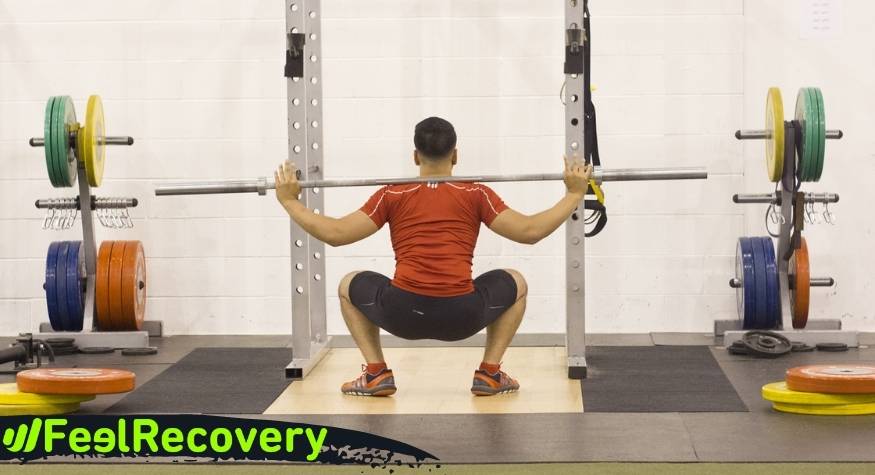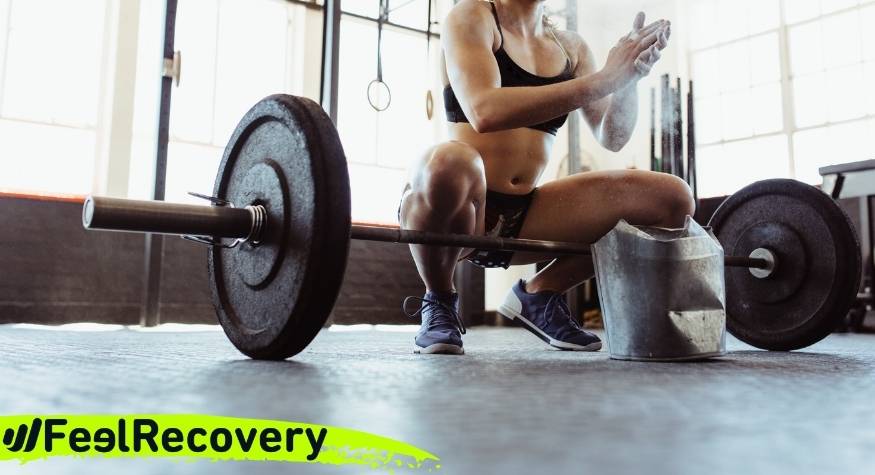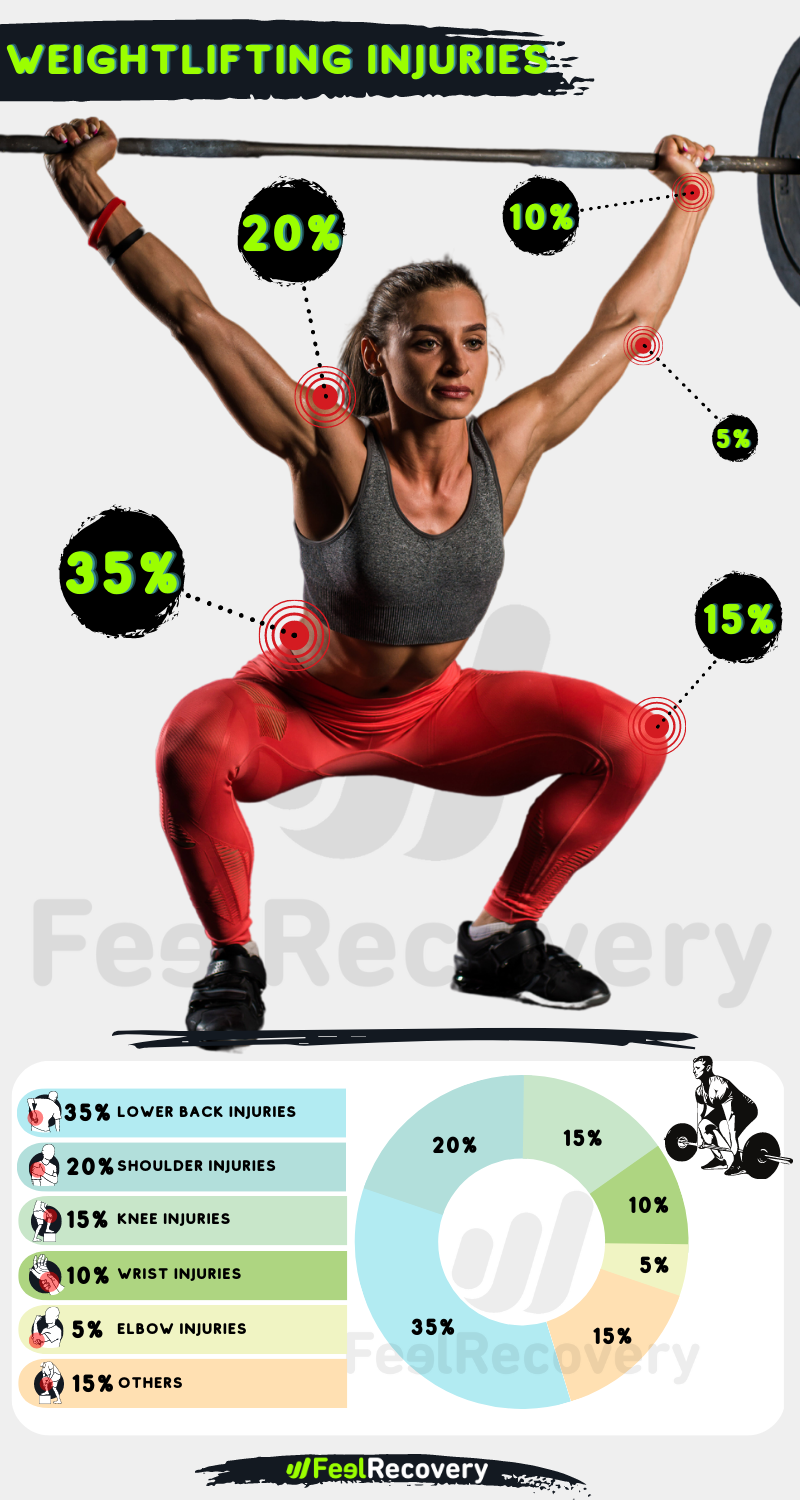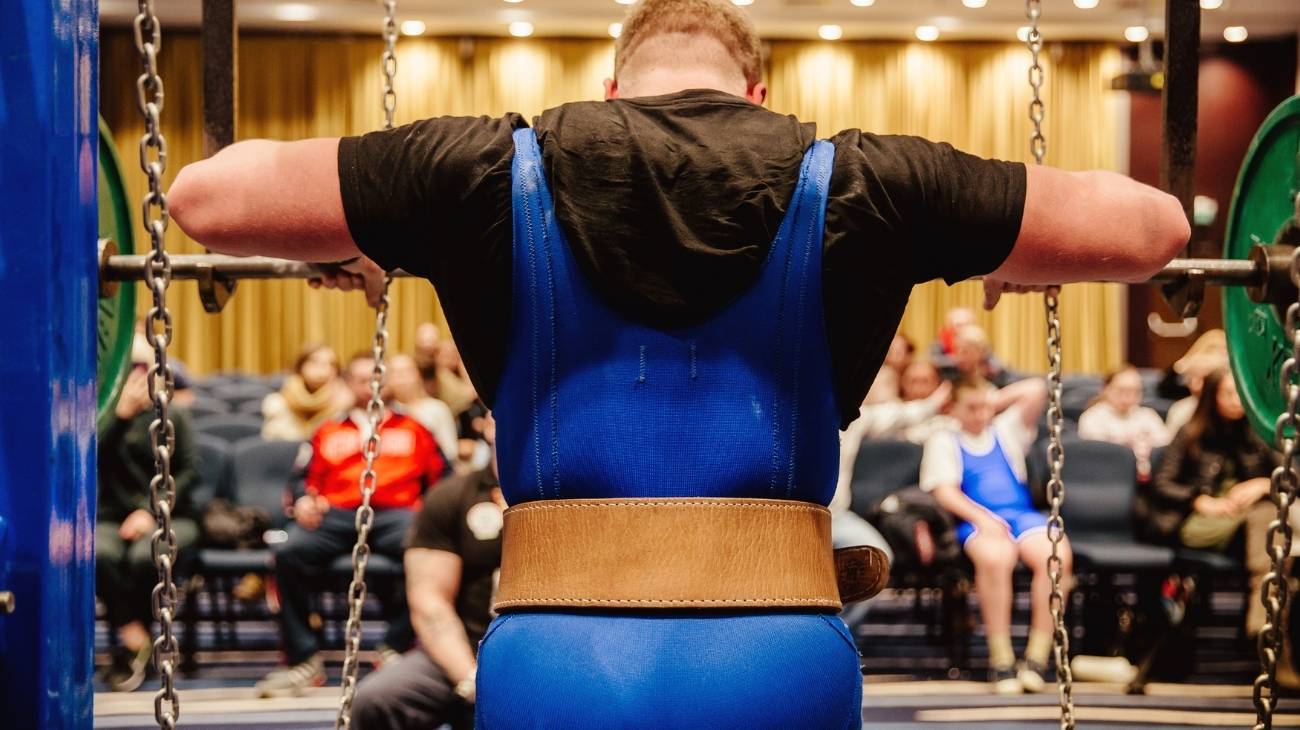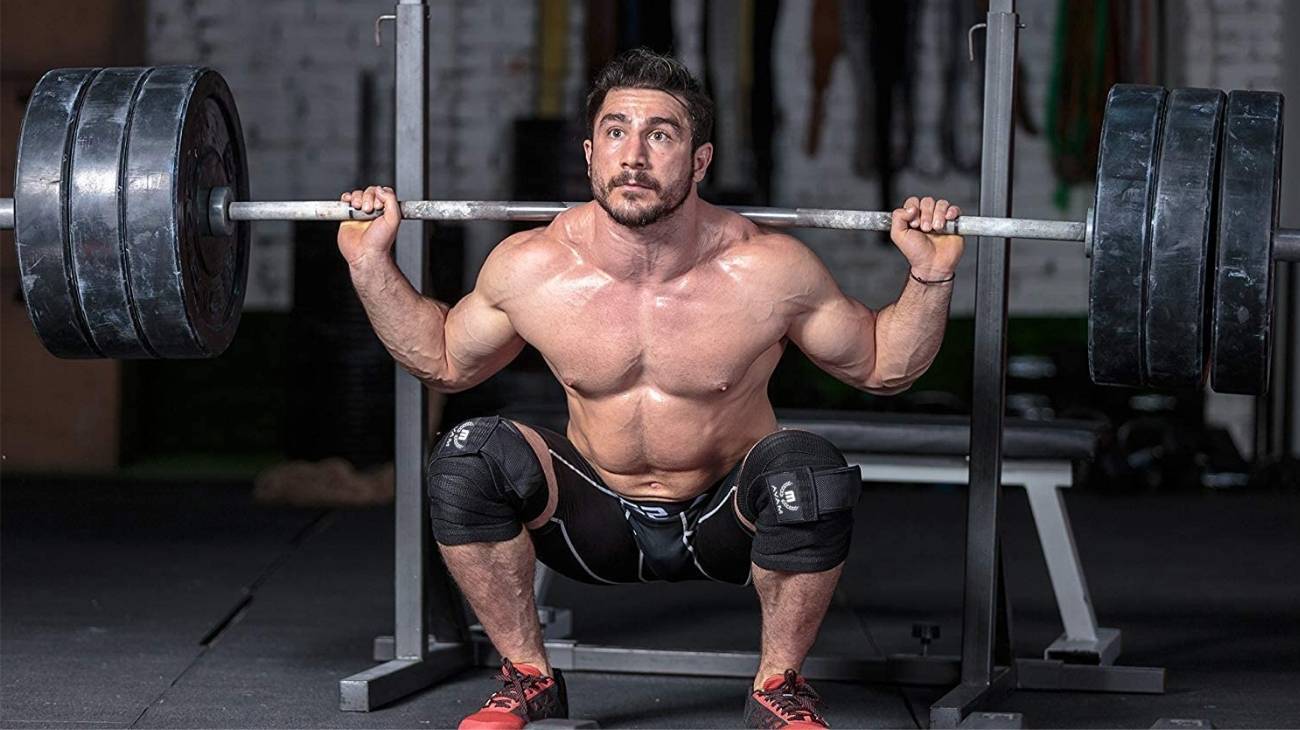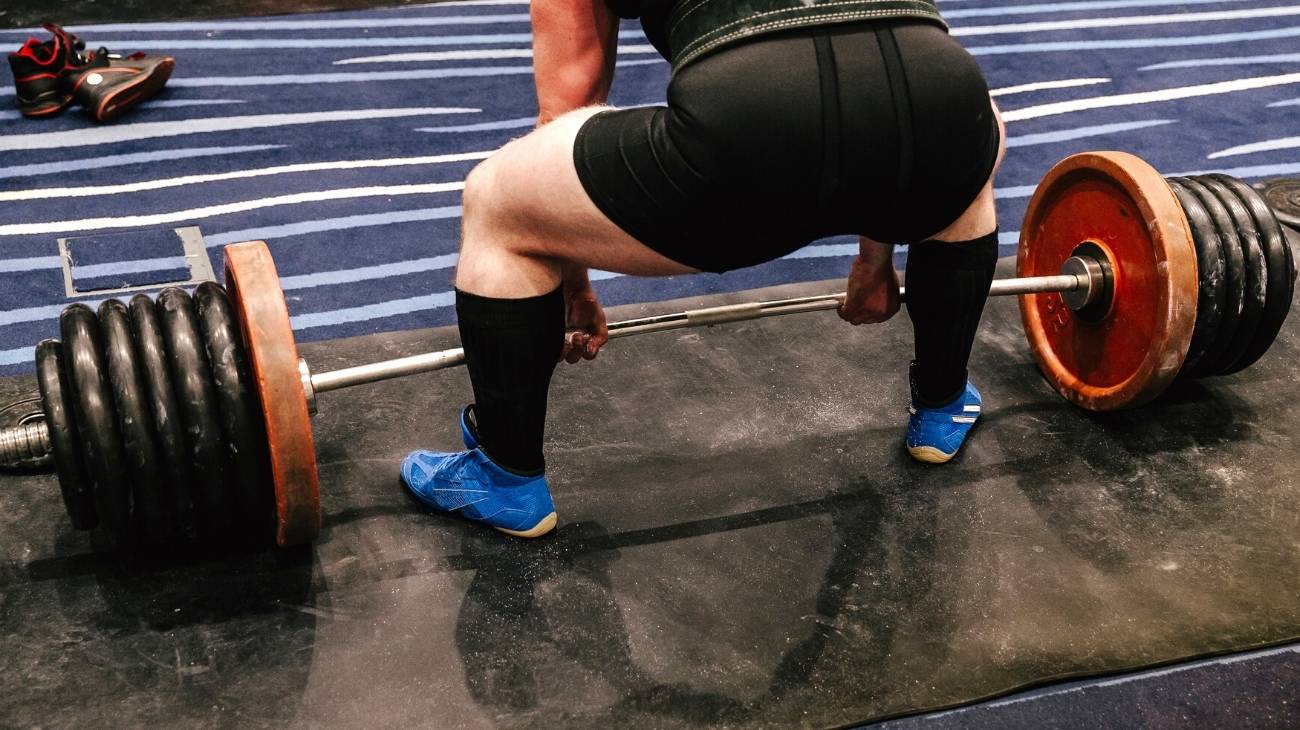- What are the most common types of injuries when weightlifting?
- Best products for Weightlifting injury recovery
- How to prevent injuries when lifting weights?
- How to apply the RICE therapy to treat first aid injuries in weightlifting or gymnastics?
- When should we see a specialist for the treatment of weightlifting injuries?
The sport as we know it today dates back to 1896, when it was integrated into the Athens Olympics in the same year. There are now varieties in its execution, but it remains a sport of maximum and explosive strength and one of the most admired in the sporting world.
In this article you will find out what are the most common weightlifting injuries, what to do to prevent injuries, how to apply the PRICE therapy for minor injuries, when it is a good time to see a sports doctor and what products are most commonly used during physical recovery.
What are the most common types of injuries when weightlifting?
In weightlifting there is always going to be a risk of injury, as we have mentioned, it is a sport of strength in which weightlifters (as these athletes are called) are able to lift more than 100 kg above their body weight.
There are two modalities in force: Snatch and Clean and Jerk. In both the demands on the body are high and in order to avoid injuries, excellent technique and high mental strength are required. Find out about the most common injuries in Olympic weightlifting.
Ligament wear and tear
Weightlifters have constant wear and tear on their knee ligaments due to the immense pressure the joints endure during the lifts, especially the snatch, which involves a bending movement of up to 90 degrees. Over the years, these movements wear down the ligaments until they tear and lose their elasticity, i.e. their ability to recover and relax after the lifts.
It is an injury that initially shows no symptoms until the day when our ligaments are already too worn out. The solution is to go regularly to the physio to have your condition assessed every year so that you can be sure of your state of health.
Knee sprain
Whether it is in the Snatch and Clean and Jerk, your body can lose balance and your knee can move side ways, if we add the heavy weight on your knees in the lifts, then there is a high probability that there is a pull that tears all or part of the ligaments. When one or more ligaments of the knee are stretched excessively, a sprain occurs, which can be of three degrees, in the most severe case there is a total rupture and surgery is required to recover.
Meniscus tear
Each knee has two menisci, they have the function of generating smoothness in the movement of the knee. When they are torn, you feel pain that increases progressively and limits mobility. The cartilage that makes up the meniscus wears down and there is no possibility of regeneration on its own. Even if you have an excellent technique, lifting weights will cause the cartilage to lose its functionality.
Depending on the intensity of the meniscus injury, physiotherapy may be all that is required, but otherwise, only surgery can correct the damage.
Muscle contracture
The back is another of the most affected parts of the body and the damage usually occurs at the start, i.e. when the weightlifter starts the lift either to raise the bar over the head or to let it rest on his shoulders.
It is very common for this type of muscle pull to occur in the lower back area, i.e. in the lumbar region, as intense and long training sessions load this area and if we do not perform good warm-ups and mobility exercises, the risk of muscle pulls increases, although we are never exempt from risks when we work with high weights.
Trapezius contracture
There should be a specific warm-up just for the trapezius, because when this muscle group contracts there is a rather annoying discomfort in the lower neck and upper back that makes it impossible to train properly.
Although in weightlifting, the weight is mostly supported by the legs, there is a period of time when the arms and shoulders do all the work to support the weight of the bar. A good warm-up before competing is important if you want to avoid trapezius contracture, and muscle compensation exercises are also recommended.
Rotator cuff shoulder injury
This is a group of soft tissues, muscles, ligaments and tendons that make the shoulder the most mobile joint in the body. When the bar rests on the athlete's collarbone, the risk of injury is greatest.
By training the pectoralis major and medius, you facilitate the work of the shoulders to finish the lifting manoeuvre and finally stretch the arms upwards to complete the exercise. Any of these tissues can be partially or completely ruptured to the point of becoming inflamed and causing pain.
Subscapularis tendonitis
This is a spotty ailment in the scapular tendon, located in the shoulders. This tissue is the most important in terms of giving stability and rotation to the joint, so when it becomes irritated or inflamed it puts the athlete out of competition.
The subscapularis is part of the rotator cuff of the shoulder, but when there is poor lifting technique, there is usually some damage to it. There may only be irritation of the tendon, but micro tears or complete rupture can also occur.
Triceps sprain
When the weightlifter lifts the bar overhead, it is likely that the arms are not kept stable by the weight of the discs and generate unusual movements, then the ligaments are partially or completely torn by the strain. Trying to stretch the elbow will cause pain in the upper triceps area. It is recommended to apply the PRICE therapy which you will learn at the end of this article.
Median nerve neuritis
The pressure on the hands and the tension of the shoulders cause compression of the nerves in the forearm until a tingling sensation and numbness appear. The forearm muscles must be strong to avoid this recurring complaint. Grip strength is very important in this sport.
The pain starts on the inner side of the elbow joint, then you notice that there is a general muscle weakening and that you have difficulty moving the ring and index fingers, all of these symptoms can be of medium, low or high intensity.
Overload of the psoasiliac muscle
This is a discomfort that affects the lower back, hip and thigh. It is inflammation due to wear and tear and micro fibrillar tears of two muscles: the iliacus and the psoas. It is a muscle group that is difficult to access, it is located in the innermost part of the human body, therefore its treatment requires expert hands to be able to access it.
This muscle allows the movement of the hip and the flexion of the spine. It is a key point in weightlifting, as the hip will be, to a large extent, the initiator of the energy necessary for the lifting of the bar, as well as possessing great strength, the hip requires great mobility.
Best products for Weightlifting injury recovery
Bestseller
-
2 Calf Compression Sleeve (Black/Gray)
$19.95 -
2 Calf Compression Sleeve (Green/Navy)
$19.95 -
2 Calf Compression Sleeve (Pink/Bordeaux)
$19.95 -
2 Elbow Compression Sleeve (Black/Gray)
$19.95 -
2 Elbow Compression Sleeve (Green/Navy)
$19.95 -
2 Elbow Compression Sleeve (Pink/Bordeaux)
$19.95 -
2 Knee Compression Sleeve (Black/Gray)
$19.95 -
2 Knee Compression Sleeve (Green/Navy)
$19.95 -
2 Knee Compression Sleeve (Pink/Bordeaux)
$19.95 -
2 Thigh Compression Sleeve (Black/Gray)
$19.95 -
2 Thigh Compression Sleeve (Green/Navy)
$19.95 -
2 Thigh Compression Sleeve (Pink/Bordeaux)
$19.95 -
Acupressure Mat and Pillow (Black/Gray)
$49.95 -
Acupressure Mat and Pillow (Green/Navy)
$49.95 -
Acupressure Mat and Pillow (Pink/Bordeaux)
$49.95 -
Acupressure Pillow (Black/Gray)
$29.46 -
Acupressure Pillow (Green/Navy)
$29.46 -
Acupressure Pillow (Pink/Bordeaux)
$29.46 -
Back Support Belt (Black)
$34.95 -
Back Support Belt (Green)
$34.95 -
Back Support Belt (Pink)
$34.95 -
Foot Massage Roller for Plantar Fasciitis (Black)
$19.95 -
Foot Massage Roller for Plantar Fasciitis (Green)
$19.95 -
Foot Massage Roller for Plantar Fasciitis (Pink)
$19.95 -
High Density Foam Roller for Muscle (Black/Gray)
$29.95 -
High Density Foam Roller for Muscle (Green/Navy)
$29.95 -
High Density Foam Roller for Muscle (Pink/Bordeaux)
$29.95 -
Ice Massage Roller Ball (Black)
$39.95 -
Ice Massage Roller Ball (Green)
$39.95 -
Ice Massage Roller Ball (Pink)
$39.95 -
Microwave Heating Pad for Back Pain Relief (Extra Large) (Hearts)
$29.95 -
Microwave Heating Pad for Back Pain Relief (Extra Large) (Oxford)
$29.95 -
Microwave Heating Pad for Back Pain Relief (Extra Large) (Sport)
$29.95 -
Microwave Heating Pad for Neck & Shoulder Pain Relief (Hearts)
$24.95 -
Microwave Heating Pad for Neck & Shoulder Pain Relief (Oxford)
$24.95 -
Microwave Heating Pad for Neck & Shoulder Pain Relief (Sport)
$24.95 -
Pack 2 In 1 Foam Roller High + Soft Density (Black/Gray)
$29.95 -
Pack 2 In 1 Foam Roller High + Soft Density (Green/Navy)
$29.95 -
Pack 2 In 1 Foam Roller High + Soft Density (Pink/Bordeaux)
$29.95 -
Sacroiliac Support Belt (Black)
$24.95 -
Sacroiliac Support Belt (Green)
$24.95 -
Sacroiliac Support Belt (Pink)
$24.95 -
Shoulder Support Brace (Black)
$24.95 -
Shoulder Support Brace (Green)
$24.95 -
Shoulder Support Brace (Pink)
$24.95 -
Soft Density Foam Roller for Recovery (Black)
$29.95 -
Soft Density Foam Roller for Recovery (Green)
$29.95 -
Soft Density Foam Roller for Recovery (Pink)
$29.95 -
Trigger Point Massage Stick (Black)
$14.95 -
Trigger Point Massage Stick (Green)
$14.95 -
Trigger Point Massage Stick (Pink)
$14.95
How to prevent injuries when lifting weights?
The entire range of weightlifting training is geared towards generating maximum and explosive strength, preparing our muscles and nervous system to lift as much weight as possible in as little time as possible . Due to these repetitive and daily movements, the athlete's body is exposed to a high possibility of injury, especially for beginners who have not yet mastered the technique correctly.
Here are some tips, apart from good technique, that can prevent injury in weightlifting:
Warm-up
In a good warm-up, you want your body to be 90% adapted to the specific weightlifting training. The first thing to do is to gently and progressively move the joints and stretch all the upper and lower muscles. You can start with a light run, stationary bike or similar to increase the heart rate and gradually increase the intensity.
Although this sport is specifically a strength sport, warm-up exercises will improve flexibility and elasticity in muscles, ligaments and tendons. You should never allow muscle oxygenation to drop too low, so it is not advisable to become fatigued in the middle of a warm-up.
The simulated barbell lifts without any weights are performed next and then you increase the number of discs you need to get your body used to the different phases of weightlifting.
In full competition, the warm-up should stop between 5 and 10 minutes before the first attempt. What is the aim of the warm-up? To avoid future injury and to prepare the body for a series of more intense movements that will put every muscle to the test.
Cool down
At the end of weightlifting training, the soft tissues need to be relaxed again and only with aerobic routines can you achieve this without compromising their functionality. These are exercises that you should do to gradually lower the intensity either after training or after a competition.
Stopping a physical activity suddenly is harmful both physically and chemically, because the body releases substances that go through the bloodstream and reach every tissue in your body, either to activate or relax them, even to promote recovery.
Using the exercise bike or walking are recommended exercises for weightlifters. With both we reduce the waste metabolites produced by training until we cleanse the muscle tissue of them. It is advisable to stretch every muscle worked and pay special attention to areas where there has already been an injury.
One of the main purposes of cooling down is to prevent the recurrence of past injuries. Even a good alternating shower with hot and cold water (3 minutes at a time) will cause the skin pores to dilate and the blood vessels in the body to constrict.
The right equipment
If you want to be a professional in this sport, we recommend you to be more familiar with the clothing and equipment you are going to use, as these must be of the highest quality to avoid accidents.
- Shoes: More than just comfort and stability when stepping, a good shoe will help you to maintain a correct upright position of the whole body. It will improve the inclination you need to have when you pick up the Olympic bar and will facilitate the push you need to do to finish lifting the bar above your head. Its sole is slightly raised about 3 cm by means of a wooden or hard material heel.
- Jersey: It has two purposes, to allow flexibility of the body during all the steps of the lift and to provide some body compression to improve athletic performance. The jersey must always be tight to the body and is made of a single piece of synthetic material.
- Belt: This is a permitted protection to reduce the likelihood of lower back injuries in training and competition. It is very important that you wear the same belt in training as in competition, so that your body is adapted to it. Belts in weightlifting and powerlifting are different, a good belt should be flexible.
- Wrist straps: Like the belt, they should not be rigid because although it may not seem like it, there is quite a lot of mobility in the wrists in weightlifting. They should not be too tight either and as every body is different, you should have the wristbands in place from the warm-up to ensure that there is no cut in the blood supply.
- The bar: Its diameter should not exceed 50 millimetres. Remember to use the same type of bar all the time, the position of the fingers must be perfectly adjusted for a good lift. This bar is an Olympic bar, so it has a standard in its manufacture. There are even variations for women and men.
- The discs: The International Weightlifting Federation differentiates the weight of the discs by colour: red, 25 kg; blue, 20 kg; yellow, 15 kg; and green, 10 kg. This is the most common configuration you will see in an Olympic competition. Larger discs should be made of rubber and polyurethane, and smaller discs may be made of steel.
- The platform: You should not use just any surface for weightlifting. So much weight will ruin any surface and this special platform will prevent headaches. A platform has a wooden centre where the athlete will stand and at the ends there is rubber on which all the weight of the discs can fall.
Nutrition and hydration
In weightlifting, the basis is strength, and without muscles it is not possible for the athlete to have enough power to continue to progress in their goals. The basis of weightlifting nutrition is based on 40% carbohydrates, 30% protein and, of course, 30% fat.
Although these recommendations are standard, the ideal is to consult a nutritionist to assess your physical constitution and nutritional requirements in order to draw up a personalised nutrition plan.
The demand for energy in this sport is high, so carbohydrates are the main component of the diet, and better if they are low on the glycaemic index. Potatoes, rice, bread and pasta (better if they are wholemeal) should be constant on the table.
What happens if there is no good nutrition? The body will not have the nutrients it needs to recover quickly from fatigue, nor will it have the energy to perform the lifts. Although weightlifting is not an endurance sport, the body must be kept hydrated at all times. Drink water every 20-25 minutes during training, avoid waiting until you are thirsty to seek hydration.
Water is essential for nutrients to reach the muscles and soft tissues. If you struggle to replenish electrolytes, then choose special hydration drinks, especially if you have a competition coming up, which will allow you to be better prepared.
Fitness
Gaining weight is one thing, achieving muscle hypertrophy is another. Muscle hypertrophy is based on muscle growth by increasing the cross-section, not by increasing the number of fibres, although maximal strength training does increase the number of contractile fibres.
This muscle hypertrophy is a slow process that is related to the athlete's build, genetics, training and nutrition. There is no point in gaining muscle mass if this does not translate into a real increase in strength capacity to lift more and more weight.
When there is a tie in weightlifting scores, the athlete with the lowest body weight wins. As it is a sport that requires a very refined technique, it is advisable to go to coaches and physical trainers specialised in this discipline, as they will plan each specific training session and a season in general to get the best results out of you.
Recovery therapies
Even if you are the best athlete in the world, you will always have an injury because weightlifting will push every tissue in your body to the limit. However, it is important to use these recovery therapies to try and avoid injury.
- Sports massage: in this sport a mechanical effect is desired to allow an optimal relaxation of the tissues after training. When lifting weights, as in weightlifting, it is difficult for the muscles to return to their normal state and massage allows the tissues to relax. This generates an overall psychological feeling of relaxation. As general benefits, massage offers increased blood flow, increased sedation, improved joint range of motion and reduced tissue adhesion.
- Use of hot and cold therapies: When the body is suffering from an injury, icing is the best thing to do because it reduces inflammation. Keep ice packs handy, even if there is no injury, this will help relax the soft tissues and relieve pain in past injuries with a tendency to recur. Cold lowers blood flow and controls pain better. Heat will allow the muscle groups or tissues in the most demanding areas, such as the knees, where the joints bear a large percentage of the weight, to always be prepared.
- Use of compression garments: compressive clothing put slight pressure on our tissues to improve blood circulation, keep the tissues at a good temperature and prevent muscle injuries. In weightlifting, a classic jersey is used, but there are compressive shirts that increase muscle performance by 20%. These cover the entire torso and even the arms, but are not allowed in Olympic competitions.
- Use of acupressure therapies: This is a holistic therapy that works the musculature and energy of the body, called "Chi". There are muscle areas where there is high tension and discomfort. When stimulation by other types of massage does not work, acupressure activates local points where the energy starts to flow again and lowers the tension generated in training. Unlike acupuncture, acupressure does not use needles.
- Use of thermotherapy and cryotherapy: The application of extreme cold and extreme heat to all or part of the body to achieve specific goals. Thermotherapy reduces chronic pain, prevents injury by strengthening muscles and better delivers nutrients to the body's tissues. Temperatures of up to 58°C are used for a few minutes, although this can only be defined by a specialist. In the case of cryotherapy, it also addresses chronic pain left by unresolved injuries in time, relieves the feeling of muscle exhaustion and promotes better recovery and regeneration of damaged cells.
How to apply the RICE therapy to treat first aid injuries in weightlifting or gymnastics?
This method consists of a series of steps to follow to address minor injuries. The PRICE protocol is an update of the RICE therapy, as it is better known in the world. Let's take a look at the steps to follow in this therapy.
- Protection: Avoid sudden movements and further damage to the affected area. It is best to find a place where you feel safe and can check the injury.
- Rest: It lasts between 48 and 72 hours, depending on how much improvement you see in the injury. It is not about doing nothing, it is about reducing the body's natural movements as much as possible to favour the start of tissue regeneration.
- Ice: Apply cold to the sore parts, use a handkerchief to avoid first degree burns. Do not extend its use for more than 20 minutes.
- Compression: Apply light pressure to the affected area, but do not completely cut off the blood flow. If you feel a tingling sensation, you should loosen the elastic bandage.
- Elevation: Raise the injured limb above the level of the heart to control pain, swelling and haematoma in case of bleeding.
When should we see a specialist for the treatment of weightlifting injuries?
There are injuries in which pain will warn you that you should go to a specialist, such as grade 2 and 3 sprains. If the sprain is grade I, it may be hidden and as you don't pay attention to it, there will be an increase in damage to tendons and ligaments, aggravating the injury.
Shoulder and knee dislocations are cases to attend to immediately, as these are the joints most prone to dislocation in weightlifting training. It occurs when a bone moves out of its typical place, and this out of position can be partial or total. In both cases, immediate immobilisation is required, followed by physiotherapy sessions.
Finally, there are bone fractures of the tibia, clavicle and forearm bones. In these cases it becomes obvious that it is a fracture because the weight of the discs will cause deformation in these areas. These chronic weightlifting injuries are often caused by poor technique and although they are not common, they can occur in weightlifting.
References
- Aasa, U., Svartholm, I., Andersson, F., & Berglund, L. (2017). Injuries among weightlifters and powerlifters: a systematic review. British journal of sports medicine, 51(4), 211-219. https://bjsm.bmj.com/content/51/4/211.short
- Mazur, L. J., Yetman, R. J., & Risser, W. L. (1993). Weight-training injuries: common injuries and preventative methods. Sports Medicine, 16, 57-63. https://link.springer.com/article/10.2165/00007256-199316010-00005
- Keogh, J. W., & Winwood, P. W. (2017). The epidemiology of injuries across the weight-training sports. Sports medicine, 47(3), 479-501. https://link.springer.com/article/10.1007/s40279-016-0575-0
- Siewe, J., Rudat, J., Röllinghoff, M., Schlegel, U. J., Eysel, P., & Michael, J. P. (2011). Injuries and overuse syndromes in powerlifting. International journal of sports medicine, 32(09), 703-711. https://www.thieme-connect.com/products/ejournals/abstract/10.1055/s-0031-1277207
- Hamill, B. P. (1994). Relative safety of weightlifting and weight training. J Strength Cond Res, 8(1), 53-7. https://paulogentil.com/pdf/Relative%20Safety%20of%20Weightlifting%20and%20Weight%20Training.pdf
- Brown, E. W., & Kimball, R. G. (1983). Medical history associated with adolescent powerlifting. Pediatrics, 72(5), 636-644. https://publications.aap.org/pediatrics/article-abstract/72/5/636/49023/Medical-History-Associated-with-Adolescent
- Bengtsson, V., Berglund, L., & Aasa, U. (2018). Narrative review of injuries in powerlifting with special reference to their association to the squat, bench press and deadlift. BMJ Open Sport & Exercise Medicine, 4(1), e000382. https://bmjopensem.bmj.com/content/4/1/e000382.abstract
- Ángel Rodríguez, M., García-Calleja, P., Terrados, N., Crespo, I., Del Valle, M., & Olmedillas, H. (2022). Injury in CrossFit®: a systematic review of epidemiology and risk factors. The Physician and Sportsmedicine, 50(1), 3-10. https://www.tandfonline.com/doi/abs/10.1080/00913847.2020.1864675
- Mundt, D. J., Kelsey, J. L., Golden, A. L., Panjabi, M. M., Pastides, H., Berg, A. T., ... & Hosea, T. (1993). An epidemiologic study of sports and weight lifting as possible risk factors for herniated lumbar and cervical discs. The American journal of sports medicine, 21(6), 854-860. https://journals.sagepub.com/doi/abs/10.1177/036354659302100617
- Reddell, C. R., Congleton, J. J., Huchingson, R. D., & Montgomery, J. F. (1992). An evaluation of a weightlifting belt and back injury prevention training class for airline baggage handlers. Applied ergonomics, 23(5), 319-329. https://www.sciencedirect.com/science/article/abs/pii/0003687092902935




















































































